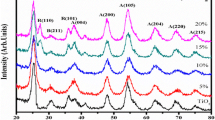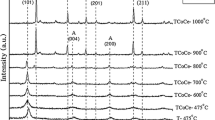Abstract
TiO2 nanopowders doped by Ni were prepared by sol–gel method. The effects of Ni ion (transition metal ion) doping on the physical structural and optical properties of TiO2 have been investigated by X-ray diffraction (XRD), scanning electron microscopy and UV–Vis absorption spectroscopy. XRD results suggest that adding impurities has a significant effect on anatase phase stability, crystallinity, and particle size of TiO2. The phase transformation from anatase to rutile was inhibited by Ni ion doped TiO2 at temperatures 675 °C. The lowest band gap value (2.83 eV) was obtained for TiO2-4%Ni sample calcined at 675 °C.
Similar content being viewed by others
References
Gopal M, Moberly Chan WJ, De Jonghe LC (1997) Room temperature synthesis of crystalline metal oxides. J Mater Sci 32(22):6001–6008
Najibi Ilkhechi N, Koozegar Kaleji BS https://doi.org/10.1007/s12633-015-9363-y
Weast RC (1984) Handbook of chemistry and physics. CRC Press, Boca Raton. B–154-155
Kostov I (1973) Minerology, 3rd edn. Nauka, Izkustia, Sofia
Fujishima A, Honda K (1972) Electrochemical photolysis of water at a semiconductor electrode. Nature 238(5358):37
Wang CY, Liu CY, Shen T (1997) The photocatalytic oxidation of phenylmercaptotetrazole in TiO2 dispersions. J Photochem Photobiol A Chem 109(1):65–70
Palmer FL, Eggins BR, Coleman HM (2002) The effect of operational parameters on the photocatalytic degradation of humic acid. J Photochem Photobiol A Chem 148(1–3):137–143
Ilkhechi NN, Ghobadi N (2016) Comparison of structural, optical, photocatalytic behavior and hydrophilic properties of pure and Sn/La co-doped TiO2 thin films. J Mater Sci Mater Electron 27(11):12050–12059
Ilkhechi NN, Kaleji BK (2016) Effect of Cu2+, Si4+ and Zr4+ dopant on structural, optical and photocatalytic properties of titania nanopowders. Opt Quant Electron 48(7):347
Hermann J. (1999) Heterogeneous photocatalysis: Catal Today 53:115–129
Hwang KS, Jeong JH, Ahn JH, Kim BH (2006) Hydrophilic/hydrophobic conversion of Ni-doped TiO2 thin films on glass substrates. Ceram Int 32(8):935–937
Kaleji BK, Alijani M, Aghaei A (2016) Sn/Ce co-doping of TiO2 nanoparticles: influence of dopants concentration on optical and structural characteristics. J Mater Sci Mater Electron 27(8):8524–8531
Alijani M, Kaleji BK, Rezaee S (2017) Improved visible light photocatalytic activity of TiO2 nano powders with metal ions doping for glazed ceramic tiles. Opt Quant Electron 49(6):225
Supha C, Boonto Y, Jindakaraked M, Ananpattarachai J, Kajitvichyanukul P (2015) Long-term exposure of bacterial and protozoan communities to TiO2 nanoparticles in an aerobic-sequencing batch reactor. Sci Technol Adv Mater 16(3):034609
Alijani M, Kaleji BK, Rezaee S (2017) Highly visible-light active with Co/Sn co-doping of TiO2 nanoparticles for degradation of methylene blue. J Mater Sci Mater Electron 28(20):15345–15353
Ilkhechi NN, Alijani M, Kaleji BK (2016) Optical and structural properties of TiO2 nanopowders with Co/Ce doping at various temperature. Opt Quant Electron 48(2):148
Linsebigler AL, Lu G, Yates Jr. JT (1995) Photocatalysis on TiO2 surfaces: principles, mechanisms, and selected results. Chem Rev 95(3):735–758
Lim Y-M, Jeong JH, An JH, Jeon YS, Jeon KO, Hwang KS, Kim BH (2005) Nickel-doped titanium oxide films prepared by chemical solution deposition. J Ceram Process Res 6(4):302
Kim Y-S, Chung Y-C, Lee KS (2006) The electronic structure of Ni doped rutile TiO2. J Electroceram 17(2–4):951–953
Carp O, Huisman CL, Reller A (2004) Carbon-Inorganic hybrid materials: the carbon nanotube/TiO2 interface. Solid Prog State Chem 32:42
Nakai I, Sasano M, Inui K, Korekawa T, Ishijima H, Katoh H, Li YJ, Kurisu M (2013) Oxygen vacancy and magnetism of a room temperature ferromagnet Co-doped TiO2. J Korean Phys Soc 63(3):532–537
Author information
Authors and Affiliations
Corresponding author
Rights and permissions
About this article
Cite this article
Alijani, M., Ilkhechi, N.N. Effect of Ni Doping on the Structural and Optical Properties of TiO2 Nanoparticles at Various Concentration and Temperature. Silicon 10, 2569–2575 (2018). https://doi.org/10.1007/s12633-018-9792-5
Received:
Accepted:
Published:
Issue Date:
DOI: https://doi.org/10.1007/s12633-018-9792-5




